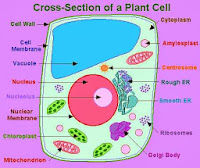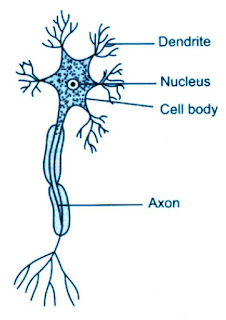Cell: Structure and Function Class VIII CBSE
Cell:
Structure and Function
Brief History of Cell
Discovery
An English
scientist, Robert Hooke, discover cell in 1665. When he was examining a
dried section of cork tree with his own made light microscope, he saw many
honeycomb like empty chambers in it. He named each hollow space as cell.
After his
discovery of cell, considerable progress has been made in the development of
powerful and more sophisticated microscopes.
In 1831,
Scottish scientist Robert Brown named nucleus of a cell.
In 1839,
Parkenje named Protoplasm.
All organisms are composed of one or more
cells.
The cell is the most basic unit of
structure, function, and organization in all organisms.
All cells arise from pre-existing, living
cells.
Cell is Unit of Life:
Starting
from the unicellular living organisms all plants and animals are made up of one
or more cells. Hence cell is called structural unit of living organism.
Again, all
the activities like respiration, nutrition etc of living organism is performed
in the cell. So, cell is called functional unit of living organism.
Shape and Size of Cell:
There are
various shape of cell like circular, oval, rectangular, cuboidal, columnar etc.
The smallest
cell in size – Microplasma Ledlai
The largest
animal cell in size – Ostrich egg
The largest
cell in human body – Nerve cell
The largest
unicellular plant cell – Acetabularia
The largest
multi-cellular plant cell – Ramie
Structure and Functions
of Different Parts of a cell:
The
different parts of a eukaryotic cell are
1. Cell wall and Cell membrane
2. Cytoplasm
3. Nueleus
4. Centrosome
5. Plastid
6. Mitochondria
7. Golgi bodies
8. Ribosome
9. Endoplasmic reticulum
10. Lysosome
11. Vacuole
12. Ergastic substances
1.
Cell wall and Cell membrane:
Definition: The thick, rigid, porous,
permeable, non-living, outer envelope of plant cells made up of cellulose is
called the cell wall.
Structure: It is lying just outside the cell
membrane of most of the plant cells. It is consist of three layers (a) Primary
cell wall, (b) Secondary cell wall, (c) Middle lamella.
Function: (i) Gives shape and rigidity to
cell.
(ii) It protects the
protoplasm from external injury.
(iii) Helps to cell conduction
of water and different chemical substances.
Cell Membrane:
Definition: The thin flexible semi-permeable living membrane that surrounds the
protoplasm of a cell and made up of proteins and lipid is called the cell
membrane or plasma membrane.
Structure: It is made up of three layers- a layer of lipid which is present
between two protein layers. Such Protein-lipid-Protein (P-L-P) is called unit
membrane.
Function: (i) It give shape of the cell.
(ii) Protects the protoplasm
and cell organelles.
(iii) Controls the transfer
of food meterials and waste products inside and outside the cell.
(2) Cytoplasm:
Definition: A thick, semi-transparent, elastic fluid containing suspended particles
and a series of minute tubules and filaments is known as cytoplasm.
Structure: It is divided into two parts – The outer portion of cytoplasm near cell
membrane and relatively non-granular and transparent part is called ectoplasm.
The inner portion towards the nucleus which is granular and viscous is called endoplasm. The fluid part of the cytoplasm is called hyaloplasm
or cytoplasm matrix.
Function: (i) Various cytoplasmic organelles, the nucleus and non-living
cytoplasmic inclusions remain embedded in the cytoplasm.
(ii) The cytoplasm is the site of a
number of chemical reactions which are essentials for life.
(3) Nucleus:
Definition: The double membrane bound dense spherical protoplasmic body containing
chromosomes is called the nucleus.
Generally a single nucleus is present in
most cells. But in some cases like skeletal muscle, certain algae and fungi
have more than one nucleus. In human mature erythrocytes and plant’s sieve tube
do not contain nucleus.
Structure: Nucleus is divided into four parts-
(a) Nuclear
Membrane: It is surrounded the nucleus and separate nucleus from
surrounding cytoplasm.
(b) Nucleoplasm:
It is dense and clear mass of protoplasm present in the nucleus.
(c) Nuclear
Reticulum: It is suspended in the nucleoplasm and threads like networks
which is called nuclear reticulum.
(d) Nucleolus:
The highly refractile, dense and non-membranous spherical bodies within nucleus
which is called nucleolus.
Function:
(i) It is
the centre of all chemical activities of the cell.
(ii) It
contains chromosomes and helps in transmission of heredity characters from
parents to offspring.
(iii) Helps
to initiates and regulates the cell division.
(4)Centorsome:
Definition: In animal cells one or two tiny hollow cylindrical bodies, the
centrioles, remain surrounded by a recognizable clear zone of cytoplasm and
form a complex which is known as the centrosome.
Structure: The centosome consist of two parts – the centriole and the centrospheres.
The two centrioles are collectively called diplosome.
Function:
(i) Helps in
cell division.
(ii) Helps
to create cilia and flagella.
(5) Plastid:
Definition: The pigmented or non-pigmented double membrane cytoplasmic bodies
associated with the preparation or the storage of food materials are called
plastids.
Structure: Plastids are three types – (a) chloroplastids, (b) chromoplastids, (c)
leucoplastids.
Function:
(i) Helps to
prepare food for plant
(ii) Helps
to pollination and impart various colours to the various plant organs.
(iii) Helps
to store food.
(6) Mitochondria:
Definition: The spherical or elongated double membrane bound filamentous cytoplasmic
bodies associated with cellular respiration are called as mitochondria.
Structure: The oval or rod like mitochondria possesses two unit membranes. The
outer membrane of the mitochondria is smooth but the inner membrane remains
folded inwards to form finger like projections at several points to form a
number of partitions or shelves called cristae. The two membranes lie apart
from each other and the space between them is filled up with a fluid. The
central cavity of the mitochondria enclosed be the inner membrane and cristae
is filled up with ground substance called matrix.
Function:
(i) Here
energy is liberate and known as ‘power house of the cell’.
(7) Golgi Bodies:
Definition: The parallelly arranged membrane bound cytoplasmic bodies occurring near
the nucleus and participating in the secretory process are known as the golgi
bodies.
Structure: It is flatten sacs consist of cisternae, microvesicles and vacuole.
Function:
(i) Helps to
secrete hormone, enzyme.
(ii) Helps
to form the cell walls, cell membrane.
(8) Ribosome:
Definition: Ribosomes are membranous small, dense, round and granular particles of
ribonucleo-protein.
Structure: A ribosome consists of two sub-units. The large sub-unit is dome shaped
and the smaller sub-unit forms a cap like structure. In eukaryotic cells the
sub-units consists of 60S and 40S and in prokaryotic cell 50S and 30S.
Function:
Helps to
protein synthesis. So it is called ‘Protain factory’.
(9) Endoplasmic
Reticulum:
Definition: The double membrane-bound channels of various shapes which forms
irregular net work like structure in the cytoplasm is called endoplasmic
reticulum.
It is two
types – granular and agranular endoplasmic reticulum.
Structure: It is divided into three parts (a) cisternae, (b) tubules, (c)
vesicles.
Function:
(i) Helps in
protein synthesis.
(ii)
synthesizes sterol, fats and phospholipids.
(10) Lysosome:
Definition: The single membrane enclosed tiny spheroid or irregular vesicles containing
hydrolytic enzymes which helps in both intracellular and extracellular
digestion are known as lysosome.
Structure: Mature spherical lysosome is surrounded by lipoprotein membrane. It is
divided into main two parts (a) membrane (b) matrix. Within it different
hydrolytic enzymes are present.
Function:
(i) Helps in
cellular digestion.
(ii) Helps
in autolysis.
Lysosome is
called suicidal bag.
(11) Vacuole:
Definition: The single membrane bound cavities containing a kind of watery fluid (cell
sap) present within the cytoplasm are called the vacuoles.
Structure: In premature state plant cell contain several small vacuoles but in
mature state it contain one or two large vacuoles. Vacuole is filled up with
watery fluid known as cell sap and surrounded by a membrane called tonoplast.
Function:
(i) Helps to
store food.
(ii) Helps
plant to float on water.
(iii) Helps
to excrete waste, products, gases etc.
(12) Eragastic
Substances:
Definition: All inert non-living and protoplasmic inclusion of the cell are
together known as the ergastic substances or ergastoplasm.
They are
mainly three types – (a) reserved substances (b) secretory substances (c)
excretory substances.


